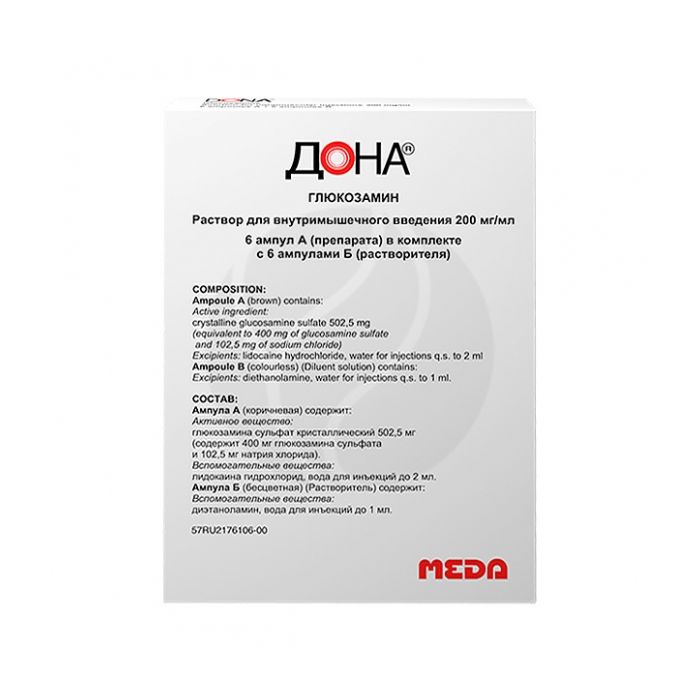Dona injection solution 200mg / ml, 2ml No. 6
Expiration Date: 05/2027
Russian Pharmacy name:
Дона раствор для инъекций 200мг/мл, 2мл №6
Primary and secondary osteoarthritis, osteochondrosis, spondyloarthrosis.
INTRAMUSCULAR! The drug is not intended for intravenous administration.
Before use, mix solution B (solvent) with solution A (drug solution) in one syringe. The prepared solution of the drug is injected intramuscularly in a dose of 3 ml (solutions A + B) 3 times a week for 4-6 weeks. Injections of the drug can be combined with taking the drug orally in powder for the preparation of a solution for oral administration (sachets).
The duration and regimen of treatment are prescribed by the attending physician.
Solution A: each ampoule (2 ml) contains:
active substance: crystalline glucosamine sulfate 502.5 mg (contains 400 mg glucosamine sulfate and 102.5 mg sodium chloride);
excipients: lidocaine hydrochloride 10.0 mg, water for injection up to 2 ml.
Solution B: ampoule (1 ml) contains:
excipients: diethanolamine - 24.0 mg, water for injection up to 1 ml
Individual hypersensitivity to glucosamine, lidocaine hydrochloride and other components of the drug. Due to the presence of lidocaine in the product, it is contraindicated in patients with cardiac conduction disorders and acute heart failure, a history of epileptiform seizures, severe liver and kidney dysfunctions;
during pregnancy and lactation, as well as in children under 12 years of age.
With caution The drug should be used with caution in patients with chronic heart failure, arterial hypotension. Caution should be exercised in patients allergic to seafood (shrimp, shellfish).
Pharmacological properties
DONA - has anti-inflammatory and analgesic effects, replenishes endogenous glucosamine deficiency, stimulates the synthesis of proteoglycans and hyaluronic acid in synovial fluid; increases the permeability of the joint capsule, restores enzymatic processes in the cells of the synovial membrane and articular cartilage. Promotes sulfur fixation during the synthesis of chondroitinsulfuric acid, facilitates the normal deposition of calcium in bone tissue, inhibits the development of degenerative processes in the joints, restores their function, reducing joint pain.
Pharmacokinetics
When administered intramuscularly, bioavailability is 95%, rapidly spreads in tissues, half-life is about 60 hours, excreted mainly by the kidneys.
Side effect
The drug is well tolerated.
In some cases: flatulence, diarrhea, constipation, allergic reactions - urticaria, itching.
Due to the content of lidocaine in the preparation, the following are possible: nausea, vomiting, drowsiness, diplopia, headache, dizziness, numbness of the tongue and oral mucosa, tremors, euphoria, disorientation, impaired cardiac conduction.
Application during pregnancy and lactation
Contraindicated during pregnancy and lactation.
Application for violations of liver function
Contraindicated in severe liver dysfunctions.
Application for impaired renal function
Contraindicated in severe renal impairment.
Application in children
Contraindicated in children under 12 years of age.
special instructions
When using the drug in patients with impaired glucose tolerance, with severe hepatic and renal failure, medical supervision is required.
Overdose
Overdose cases were not noted.
Drug interactions
Compatible with NSAIDs, paracetamol and glucocorticosteroids.
Care should be taken when prescribing injections of the drug in combination with beta-blockers, digitoxin, aymalin, amiodarone, verapamil, quinidine, novocainamide, hexenal or sodium thiopental, MAO inhibitors, polymyxin B, hypnotics or sedatives, cimetidine.

